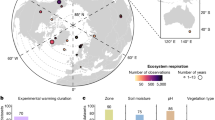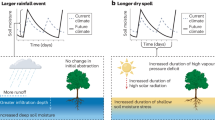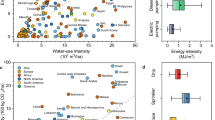Abstract
Enhanced plant biomass accumulation in response to elevated atmospheric CO2 concentration could dampen the future rate of increase in CO2 levels and associated climate warming. However, it is unknown whether CO2-induced stimulation of plant growth and biomass accumulation will be sustained or whether limited nitrogen (N) availability constrains greater plant growth in a CO2-enriched world1,2,3,4,5,6,7,8,9. Here we show, after a six-year field study of perennial grassland species grown under ambient and elevated levels of CO2 and N, that low availability of N progressively suppresses the positive response of plant biomass to elevated CO2. Initially, the stimulation of total plant biomass by elevated CO2 was no greater at enriched than at ambient N supply. After four to six years, however, elevated CO2 stimulated plant biomass much less under ambient than enriched N supply. This response was consistent with the temporally divergent effects of elevated CO2 on soil and plant N dynamics at differing levels of N supply. Our results indicate that variability in availability of soil N and deposition of atmospheric N are both likely to influence the response of plant biomass accumulation to elevated atmospheric CO2. Given that limitations to productivity resulting from the insufficient availability of N are widespread in both unmanaged and managed vegetation5,7,8,9, soil N supply is probably an important constraint on global terrestrial responses to elevated CO2.
This is a preview of subscription content, access via your institution
Access options
Subscribe to this journal
Receive 51 print issues and online access
$199.00 per year
only $3.90 per issue
Buy this article
- Purchase on Springer Link
- Instant access to full article PDF
Prices may be subject to local taxes which are calculated during checkout

Similar content being viewed by others
References
Intergovernmental Panel on Climate Change. Climate Change 2001: The Scientific Basis (Cambridge Univ. Press, New York, 2001)
Rastetter, E. B., Agren, G. I. & Shaver, G. R. Responses of N-limited ecosystems to increased CO2: a balanced-nutrition coupled-element-cycles model. Ecol. Appl. 7, 444–460 (1997)
McMurtrie, R. E., Dewar, R. C., Medlyn, B. E. & Jeffreys, M. P. Effects of rising CO2 on growth and carbon sequestration in forests: a modelling analysis of the consequences of altered litter quantity and quality. Plant Soil 224, 135–152 (2000)
Zak, D. R., Pregitzer, K. S., Curtis, P. S. & Holmes, W. E. Atmospheric CO2 and the composition and function of soil microbial communities. Ecol. Appl. 10, 47–59 (2000)
Oren, R. et al. Soil fertility limits carbon sequestration by forest ecosystems in a CO2 enriched world. Nature 411, 469–472 (2001)
Shaw, M. R. et al. Grassland responses to global environmental changes suppressed by elevated CO2 . Science 298, 1987–1990 (2002)
Hungate, B. A., Dukes, J. S., Shaw, M. R., Luo, Y. Q. & Field, C. B. Nitrogen and climate change. Science 302, 1512–1513 (2003)
Luo, Y. et al. Progressive nitrogen limitation of ecosystem responses to rising atmospheric carbon dioxide. Bioscience 54, 731–739 (2004)
Schneider, M. K. et al. Ten years of free-air CO2 enrichment altered the mobilization of N from soil in Lolium perenne L. swards. Glob. Change Biol. 10, 1377–1388 (2004)
Lloyd, J. & Farquhar, G. D. The CO2 dependence of photosynthesis, plant growth responses to elevated atmospheric CO2 concentrations, and their interactions with soil nutrient status. I. General principles and forest ecosystems. Funct. Ecol. 10, 4–32 (1996)
Peterson, A. G. et al. The photosynthesis–leaf nitrogen relationship at ambient and elevated atmospheric carbon dioxide: a meta-analysis. Glob. Change Biol. 5, 331–346 (1999)
Zak, D. R., Holmes, W. E., Finzi, A. C., Norby, R. J. & Schlesinger, W. H. Soil nitrogen cycling under elevated CO2: a synthesis of forest face experiments. Ecol. Appl. 13, 1508–1514 (2003)
Vitousek, P. M. et al. Human alteration of the global nitrogen cycle: sources and consequences. Ecol. Appl. 7, 737–750 (1997)
Luo, Y., Field, C. B. & Mooney, H. A. Predicting responses of photosynthesis and root fraction to elevated [CO2]: interactions among carbon, nitrogen and growth. Plant Cell Environ. 17, 1195–1204 (1994)
Cannell, M. & Thornley, J. N-poor ecosystems may respond more to elevated [CO2] than N-rich ones in the long term. A model analysis of grassland. Glob. Change Biol. 4, 431–442 (1998)
Gill, R. A. et al. Nonlinear grassland responses to past and future atmospheric CO2 . Nature 417, 279–282 (2002)
Williams, M. A., Rice, C. W. & Owensby, C. E. Carbon dynamics and microbial activity in tallgrass prairie exposed to elevated CO2 for 8 years. Plant Soil 227, 127–137 (2000)
Reich, P. B. et al. Plant diversity enhances ecosystem responses to elevated CO2 and nitrogen deposition. Nature 410, 809–812 (2001)
Finzi, A. C. & Schlesinger, W. H. Soil-nitrogen cycling in a pine forest exposed to 5 years of elevated carbon dioxide. Ecosystems 6, 444–456 (2003)
Owensby, C. E., Auen, L. M. & Coyne, P. I. Biomass production in a nitrogen fertilized, tallgrass prairie ecosystem exposed to ambient and elevated levels of CO2 . Plant Soil 165, 105–113 (1994)
Zanetti, S. et al. Does nitrogen nutrition restrict the CO2 response of fertile grassland lacking legumes? Oecologia 112, 17–25 (1997)
Zak, D. R., Pregitzer, K. S., Curtis, P. S. & Holmes, W. E. Atmospheric CO2 and the composition and function of soil microbial communities. Ecol. Appl. 10, 47–59 (2000)
Reich, P. B. et al. Species and functional diversity independently influence biomass accumulation and its response to CO2 and N. Proc. Natl Acad. Sci. USA 101, 10101–10106 (2004)
Galloway, J. N. et al. The nitrogen cascade. Bioscience 53, 341–356 (2003)
Reich, P. B. et al. Do species and functional groups differ in acquisition and use of C, N and water under varying atmospheric CO2 and N availability regimes? A field test with 16 grassland species. New Phytol. 150, 435–448 (2001)
Lee, T. D., Tjoelker, M. G., Ellsworth, D. S. & Reich, P. B. Leaf gas exchange responses of 13 prairie grassland species in the field under elevated carbon dioxide and increased nitrogen supply. New Phytol. 150, 405–418 (2001)
Craine, J. M., Wedin, D. A. & Reich, P. B. The response of soil CO2 flux to changes in atmospheric CO2, nitrogen supply, and plant diversity. Glob. Change Biol. 7, 947–953 (2001)
Dijkstra, F., Hobbie, S., Reich, P. & Knops, J. Divergent effects of elevated CO2, N fertilization, and plant diversity on soil C and N dynamics in a grassland field experiment. Plant Soil 272, 41–52 (2005)
Lüscher, A., Hartwig, U. A., Suter, D. & Nösberger, J. Direct evidence that in fertile grassland symbiotic N2 fixation is an important trait for a strong response of plants to elevated atmospheric CO2 . Glob. Change Biol. 6, 655–662 (2000)
Hungate, B. A. et al. CO2 elicits long-term decline in nitrogen fixation. Science 304, 1291 (2004)
Acknowledgements
We thank the US Department of Energy Program for Ecosystem Research, the National Science Foundation Long-Term Ecological Research and Biocomplexity Coupled Biogeochemical Cycles Programs, and the University of Minnesota for supporting this research. Author Contributions All authors were involved in the design or implementation of the experiment, or both, with P.B.R. having the major responsibility for these. P.B.R., D.E., D.T., J.K. and S.N. were involved in the initial experimental design. J.T. was responsible for a substantial fraction of the experimental management and data collection, with smaller contributions in this area from T.L., D.E., J.B.W., J.K. and S.H. P.B.R. performed the statistical analyses and wrote the paper, with assistance from S.H., T.L., D.E., S.N. and J.B.W. All authors discussed the results and commented on the manuscript.
Author information
Authors and Affiliations
Corresponding author
Ethics declarations
Competing interests
Reprints and permissions information is available at npg.nature.com/reprintsandpermissions. The authors declare no competing financial interests.
Supplementary information
Supplementary Figure 1
This file contains Supplementary Figure 1. (PDF 12 kb)
Supplementary Figure 2
This file contains Supplementary Figure 2. (PDF 12 kb)
Supplementary Figure 3
This file contains Supplementary Figure 3. (PDF 108 kb)
Supplementary Table 1
This file contains Supplementary Table 1 and the figure legends for the Supplementary Figures. (DOC 44 kb)
Supplementary Table 2
This file contains Supplementary Table 2. (DOC 54 kb)
Supplementary Methods
This file contains Supplementary Methods. (DOC 32 kb)
Rights and permissions
About this article
Cite this article
Reich, P., Hobbie, S., Lee, T. et al. Nitrogen limitation constrains sustainability of ecosystem response to CO2. Nature 440, 922–925 (2006). https://doi.org/10.1038/nature04486
Received:
Accepted:
Issue Date:
DOI: https://doi.org/10.1038/nature04486
This article is cited by
-
Deciduous trees could benefit more from the rise in [CO2] than evergreens in the Brazilian Cerrado
Plant Ecology (2024)
-
Responses of Coastal Wetlands to Rising Sea-Level Revisited: The Importance of Organic Production
Estuaries and Coasts (2024)
-
Grassland responses to elevated CO2 determined by plant–microbe competition for phosphorus
Nature Geoscience (2023)
-
Evidence and attribution of the enhanced land carbon sink
Nature Reviews Earth & Environment (2023)
-
Latitudinal patterns of soil nitrogen density across soil profiles and their driving factors in the arid valleys of southwest China
Journal of Soils and Sediments (2023)
Comments
By submitting a comment you agree to abide by our Terms and Community Guidelines. If you find something abusive or that does not comply with our terms or guidelines please flag it as inappropriate.



